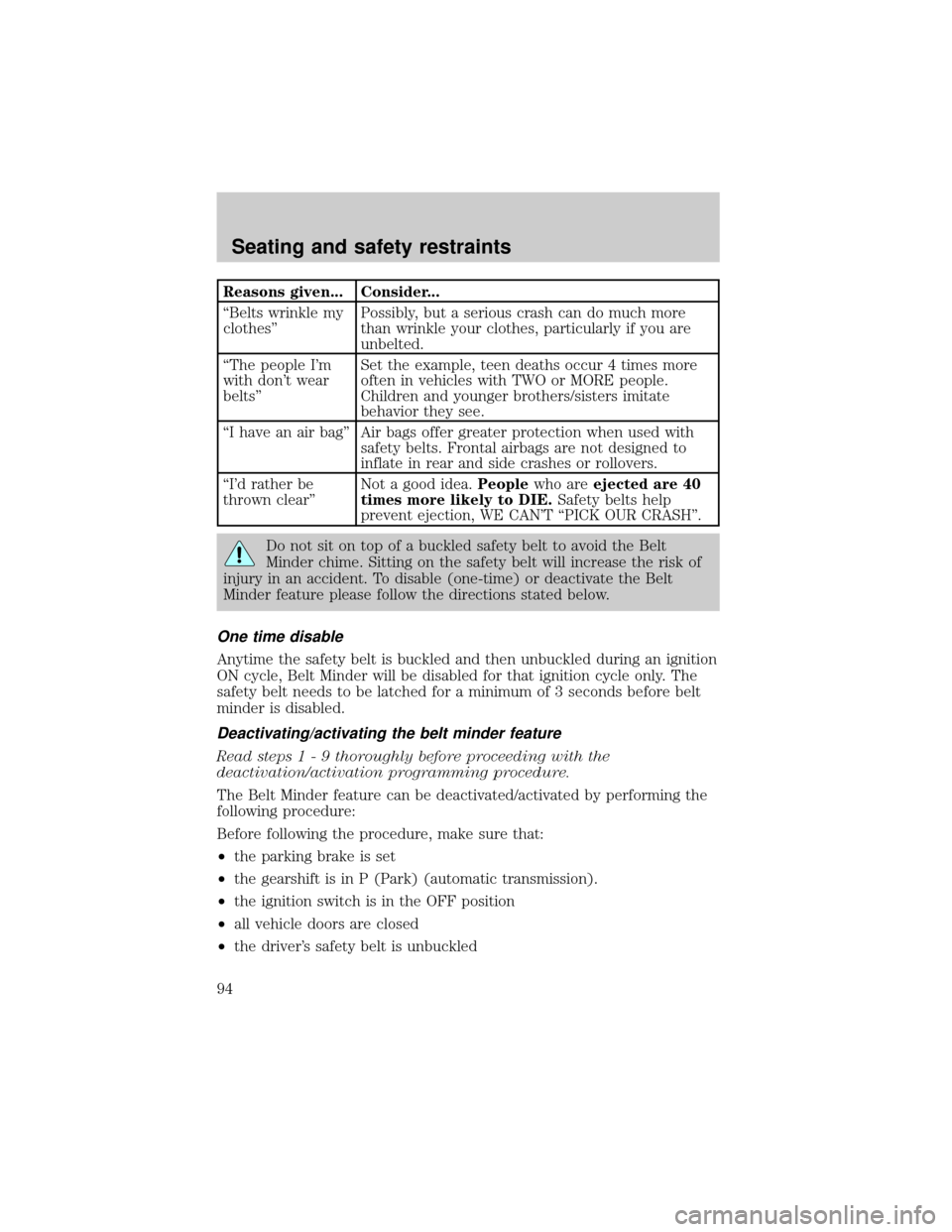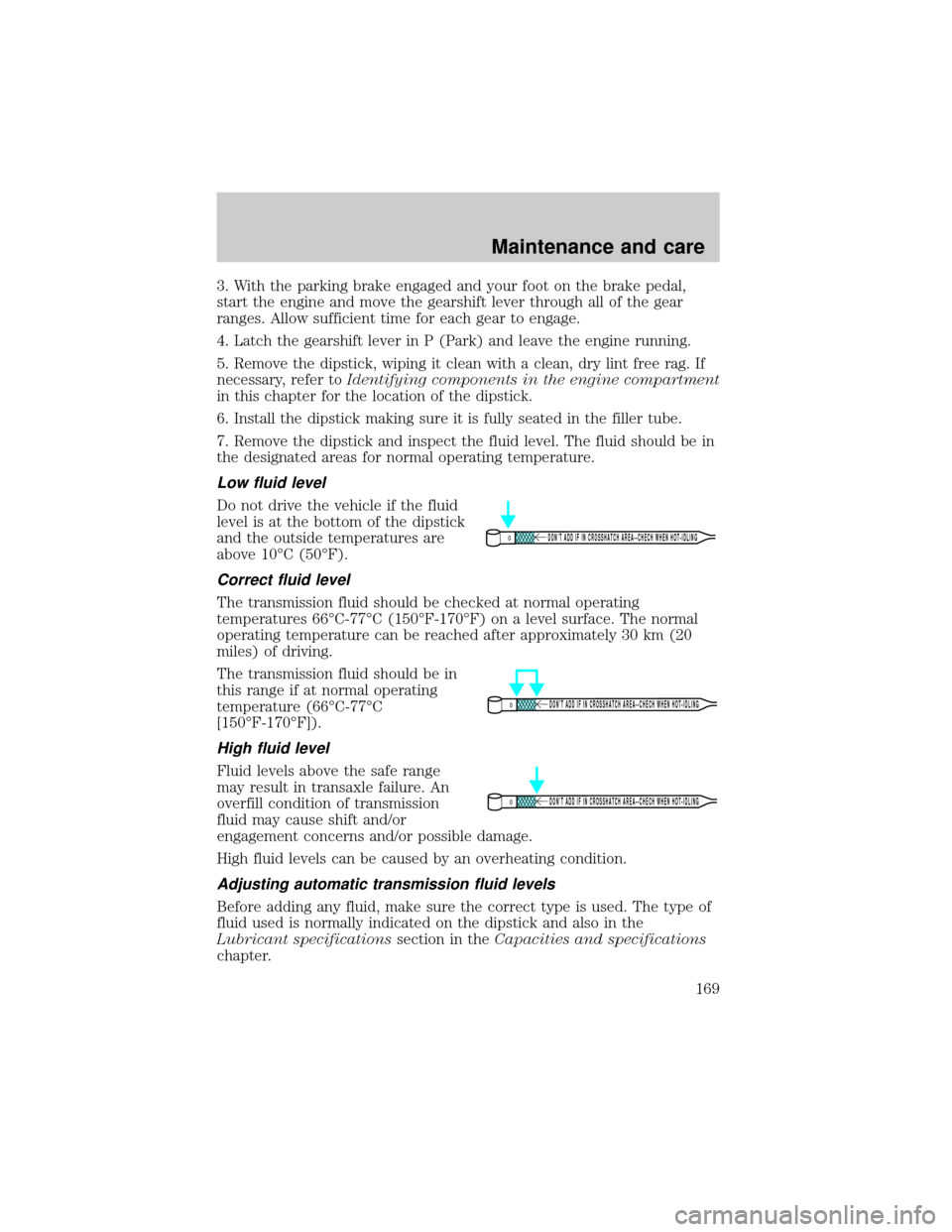automatic transmission Mercury Sable 2001 Owner's Manuals
[x] Cancel search | Manufacturer: MERCURY, Model Year: 2001, Model line: Sable, Model: Mercury Sable 2001Pages: 240, PDF Size: 2.22 MB
Page 47 of 240

POSITIONS OF THE IGNITION
1. ACCESSORY, allows the electrical
accessories such as the radio to
operate while the engine is not
running.
2. LOCK, locks the steering wheel,
automatic transmission gearshift
lever and allows key removal.
3. OFF, shuts off the engine without
locking the steering wheel.
4. ON, all electrical circuits
operational. Warning lights illuminated with engine off. Key position
when driving.
5. START, cranks the engine. Release the key as soon as the engine
starts.
SPEED CONTROL (IF EQUIPPED)
To turn speed control on
²Press ON.
Vehicle speed cannot be controlled
until the vehicle is traveling at or
above 48 km/h (30 mph).
Do not use the speed
control in heavy traffic or
on roads that are winding,
slippery, or unpaved.
Do not shift the gearshift lever into N (Neutral) with the speed
control on.
1
23
4
5
OFF
ON
Controls and features
47
Page 94 of 240

Reasons given... Consider...
ªBelts wrinkle my
clothesºPossibly, but a serious crash can do much more
than wrinkle your clothes, particularly if you are
unbelted.
ªThe people I'm
with don't wear
beltsºSet the example, teen deaths occur 4 times more
often in vehicles with TWO or MORE people.
Children and younger brothers/sisters imitate
behavior they see.
ªI have an air bagº Air bags offer greater protection when used with
safety belts. Frontal airbags are not designed to
inflate in rear and side crashes or rollovers.
ªI'd rather be
thrown clearºNot a good idea.Peoplewho areejected are 40
times more likely to DIE.Safety belts help
prevent ejection, WE CAN'T ªPICK OUR CRASHº.
Do not sit on top of a buckled safety belt to avoid the Belt
Minder chime. Sitting on the safety belt will increase the risk of
injury in an accident. To disable (one-time) or deactivate the Belt
Minder feature please follow the directions stated below.
One time disable
Anytime the safety belt is buckled and then unbuckled during an ignition
ON cycle, Belt Minder will be disabled for that ignition cycle only. The
safety belt needs to be latched for a minimum of 3 seconds before belt
minder is disabled.
Deactivating/activating the belt minder feature
Read steps1-9thoroughly before proceeding with the
deactivation/activation programming procedure.
The Belt Minder feature can be deactivated/activated by performing the
following procedure:
Before following the procedure, make sure that:
²the parking brake is set
²the gearshift is in P (Park) (automatic transmission).
²the ignition switch is in the OFF position
²all vehicle doors are closed
²the driver's safety belt is unbuckled
Seating and safety restraints
94
Page 147 of 240

11. Return the flat tire, jack and lug
wrench to their proper storage
locations. Make sure the jack is
fastened so it does not rattle when
you drive.
12. Unblock the wheels.
JUMP STARTING YOUR VEHICLE
The gases around the battery can explode if exposed to flames,
sparks, or lit cigarettes. An explosion could result in injury or
vehicle damage.
Do not push start your vehicle. You could damage the catalytic
converter.
Batteries contain sulfuric acid which can burn skin, eyes, and
clothing, if contacted.
Do not attempt to push start your vehicle. Automatic
transmissions do not have push-start capability.
Preparing your vehicle
When the battery is disconnected or a new battery is installed, the
transmission must relearn its adaptive strategy. As a result of this, the
transmission may shift firmly. This operation is considered normal and
will not effect function or durability of the transmission. Over time, the
adaptive learning process will fully update transmission operation to its
optimum shift feel.
1.Use only a 12±volt supply to start your vehicle.
Roadside emergencies
147
Page 155 of 240

IDENTIFYING COMPONENTS IN THE ENGINE COMPARTMENT
3.0L V6 Vulcan engine
1. Automatic transmission fluid dipstick
2. Brake fluid reservoir
3. Air filter assembly
4. Battery
5. Engine oil filler cap
6. Engine oil dipstick
7. Power steering fluid reservoir
8. Engine coolant reservoir
9. Windshield washer fluid reservoir
786543
912
Maintenance and care
155
Page 156 of 240

3.0L DOHC V6 Duratec engine
1. Automatic transmission fluid dipstick
2. Brake fluid reservoir
3. Air filter assembly
4. Battery
5. Engine oil filler cap
6. Engine oil dipstick
7. Engine coolant reservoir
8. Windshield washer fluid reservoir
9. Power steering fluid reservoir
7654
89123
Maintenance and care
156
Page 168 of 240

5. If the fluid is low, add fluid in small amounts, continuously checking
the level until it reaches the FULL HOT range. Be sure to put the
dipstick back in the reservoir.
3.0L DOHC V6 Duratec engine
4. Check the fluid level in the
reservoir. It should be between the
MIN and MAX lines. Do not add
fluid if the level is within this range.
5. If the fluid is low, add fluid in small amounts, continuously checking
the level until it reaches the range between the MIN and MAX lines. Be
sure to put the cap back on the reservoir.
TRANSMISSION FLUID
Checking automatic transmission fluid
Refer to your scheduled maintenance guide for scheduled intervals for
fluid checks and changes. Your transaxle does not consume fluid.
However, the fluid level should be checked if the transaxle is not working
properly, i.e., if the transaxle slips or shifts slowly or if you notice some
sign of fluid leakage.
Automatic transmission fluid expands when warmed. To obtain an
accurate fluid check, drive the vehicle until it is warmed up
(approximately 30 km [20 miles]). If your vehicle has been
operated for an extended period at high speeds, in city traffic
during hot weather or pulling a trailer, the vehicle should be
turned off for about 30 minutes to allow fluid to cool before
checking.
1. Drive the vehicle 30 km (20 miles) or until it reaches normal operating
temperature.
2. Park the vehicle on a level surface and engage the parking brake.
MINMAX
Maintenance and care
168
Page 169 of 240

3. With the parking brake engaged and your foot on the brake pedal,
start the engine and move the gearshift lever through all of the gear
ranges. Allow sufficient time for each gear to engage.
4. Latch the gearshift lever in P (Park) and leave the engine running.
5. Remove the dipstick, wiping it clean with a clean, dry lint free rag. If
necessary, refer toIdentifying components in the engine compartment
in this chapter for the location of the dipstick.
6. Install the dipstick making sure it is fully seated in the filler tube.
7. Remove the dipstick and inspect the fluid level. The fluid should be in
the designated areas for normal operating temperature.
Low fluid level
Do not drive the vehicle if the fluid
level is at the bottom of the dipstick
and the outside temperatures are
above 10ÉC (50ÉF).
Correct fluid level
The transmission fluid should be checked at normal operating
temperatures 66ÉC-77ÉC (150ÉF-170ÉF) on a level surface. The normal
operating temperature can be reached after approximately 30 km (20
miles) of driving.
The transmission fluid should be in
this range if at normal operating
temperature (66ÉC-77ÉC
[150ÉF-170ÉF]).
High fluid level
Fluid levels above the safe range
may result in transaxle failure. An
overfill condition of transmission
fluid may cause shift and/or
engagement concerns and/or possible damage.
High fluid levels can be caused by an overheating condition.
Adjusting automatic transmission fluid levels
Before adding any fluid, make sure the correct type is used. The type of
fluid used is normally indicated on the dipstick and also in the
Lubricant specificationssection in theCapacities and specifications
chapter.
DON’T ADD IF IN CROSSHATCH AREA--CHECH WHEN HOT-IDLING
DON’T ADD IF IN CROSSHATCH AREA--CHECH WHEN HOT-IDLING
DON’T ADD IF IN CROSSHATCH AREA--CHECH WHEN HOT-IDLING
Maintenance and care
169
Page 170 of 240

Use of a non-approved automatic transmission fluid may cause
internal transaxle component damage.
If necessary, add fluid in 250 mL (1/2 pint) increments through the filler
tube until the level is correct.
If an overfill occurs, excess fluid
should be removed by a qualified
technician.
An overfill condition of
transmission fluid may cause shift and/or engagement concerns
and/or possible damage.
CABIN AIR FILTER (IF EQUIPPED)
The particulate air filtration system is designed to reduce the
concentration of airborne particles such as dust, spores and pollen in the
air being supplied to the interior of the vehicle. The particulate filtration
system gives the following benefits to customers:
²Improves the customer's driving comfort by reducing particle
concentration
²Improves the interior compartment cleanliness
²Protects the climate control components from particle deposits
DON’T ADD IF IN CROSSHATCH AREA--CHECH WHEN HOT-IDLING
Maintenance and care
170
Page 232 of 240

Child safety seats ......................105
attaching with tether straps ..109
in front seat ............................106
in rear seat ......................106, 109
LATCH .....................................111
Cleaning your vehicle ...............204
engine compartment ..............207
exterior ....................................205
exterior lamps .........................206
instrument cluster lens ..........208
instrument panel ....................208
interior .............................208±209
mirrors .....................................206
plastic parts ............................206
safety belts ..............................209
washing ....................................204
waxing .....................................205
wheels ......................................206
windows ..................................209
wiper blades ............................206
woodtone trim ........................209
Climate control (see Air
conditioning or Heating) ............19
Clock ......................................35, 41
Console ........................................59
Controls
power seat .................................78
Coolant
checking and adding ..............162
refill capacities ................165, 211
specifications ..................212±213
Cruise control
(see Speed control) ....................47
Customer Assistance ................135
Ford accessories
for your vehicle ......................225
Ford Extended
Service Plan ............................217Getting assistance outside
the U.S. and Canada ..............224
Getting roadside assistance ...135
Getting the
service you need ....................217
Ordering additional
owner's literature ...................228
The Dispute
Settlement Board ...................220
Utilizing the Mediation/
Arbitration Program ...............223
D
Daytime running lamps
(see Lamps) ................................17
Defrost
rear window ..............................19
Dipstick
automatic
transmission fluid ...................168
engine oil .................................157
Doors
door ajar warning .......................9
lubricant specifications ..........212
Driving under special
conditions
through water .........................129
E
Emergencies, roadside
jump-starting ..........................147
Emission control system ..........190
Engine ........................................213
check engine/
service engine soon light ...........9
cleaning ...................................207
coolant .....................................162
Index
232
Page 236 of 240

child safety seats ....................105
cleaning ...........................208±209
SecuriLock passive
anti-theft system ...................73, 75
Servicing your vehicle ..............153
Spark plugs,
specifications .....................210, 213
Specification chart,
lubricants ...........................212±213
Speed control ..............................47
Speedometer ...............................14
Starting your vehicle ........113, 115
jump starting ..........................147
Steering wheel
tilting .........................................52
T
Tachometer .................................14
Tires ...........................143, 178±180
changing ..........................143±144
checking the pressure ............180
replacing ..................................181
rotating ....................................180
snow tires and chains ............181
tire grades ...............................179
treadwear ................................179
Towing .......................................130
recreational towing .................133
trailer towing ..........................130
wrecker ....................................152
Traction control ..................46, 121
active light ..................................8
Transaxle
automatic operation ...............123
fluid, refill capacities ..............211lubricant specifications ..........213
Transmission
fluid, checking and adding
(automatic) .............................168
lubricant specifications ..........212
Trip odometer .............................15
Trunk .........................61, 63±64, 76
remote release ..........................60
Turn signal ..............................8, 50
V
Vehicle dimensions ...................213
Vehicle Identification
Number (VIN) ...........................216
Vehicle loading ..........................128
Ventilating your vehicle ...........117
W
Warning chimes ...........................13
Warning lights (see Lights) .........8
Washer fluid ..............................161
Water, Driving through .............129
Windows
power .........................................56
rear wiper/washer .....................51
Windshield washer fluid and
wipers
checking and adding fluid .....161
checking and cleaning ....177±178
liftgate reservoir .....................162
operation ...................................50
replacing wiper blades ...........178
Wrecker towing .........................152
Index
236